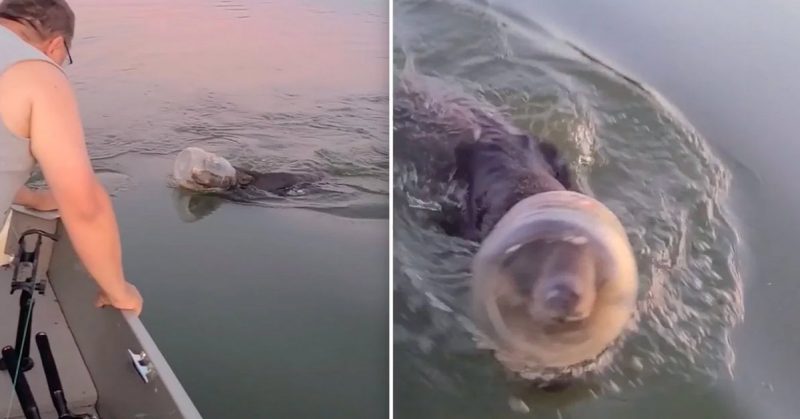That’s one more precious bear the world would have lost to the plastic pandemic, but this family wasn’t about to let that happen.
Tricia Hurt, her husband Brian, and their son Brady were out enjoying a fishing adventure on Marsh-Miller Lake in Wisconsin when they found a baby bear in major distress. [1] According to locals and resort patrons in the area, the little bear had been running on land with a plastic tub on his head for three to four days, but he somehow got into the water, worsening his condition.

From Tricia’s heartwarming video, the bear could be seen swimming in fear and shifting away from the family as they edged the boat closer. He was terrified, but the tub was quickly filling with water and he was in danger of drowning.
“Go a little faster, Brady. Get in front of him,” Tricia instructed her son to navigate the boat closer to the animal.
Her husband, Brian, got close to the bear and tried to the pull tub out, but it had become too slippery. Brian lost his grip, but he wasn’t discouraged because the bear’s ear had managed to come loose. That meant the plastic wasn’t impossibly stuck and he just had to get closer.
Finally, the baby bear was set free
According to Tricia, the incredible ordeal lasted about five minutes and they made several attempts before the tub finally came off. Brady circled the boat around to the bear and his father gave one last tug that set the animal free. Once it came off, the bear was able to swim easily to the shore and catch a much-needed break.
The family was immensely relieved as Tricia called out to the sailing animal, “Swim happy.”

“We were so excited! We did our good deed for the day. We will never ever do this again, and it felt good to help the poor bear. You don’t like to see animals struggle,” Tricia later said in an interview.
When the Hurts returned to their resort, the other patrons at the bar had already been informed of their recuse mission and everyone offered their gratitude. No one else had been able to help the bear for several days as it roamed the shores with the deadly tub over its head.
Tricia hadn’t wanted to post the video online, but she figured people from the area would have wanted to know the bear was okay. She shared it on Facebook with the caption: “Never dreamt we would ever do this in our lifetime. Out on Marshmiller Lake yesterday with Brian Hurt and Brady Hurt when we spotted this poor bear. He made it to shore after all that.”
The video was posted on Sunday, June 28, and it has so far garnered 1.7 million views and 24K shares. We need more people like the Hurts!
The poor bear was minutes away from becoming another point in the outrageous figures
While it’s nearly impossible to record the exact numbers, researchers say that approximately 8 million metric tons of plastic waste infiltrate the oceans and seas every year. [2] This is in addition to the 15 million metric tons already circulating in global waters. Plastics are non-biodegradable and could take anywhere from hundreds to thousands of years to fully decompose.
One of the major problems affecting aquatic life on earth is plastic infestation. Every year, an estimated 1 million marine animals (including mammals, fish, sharks, turtles, and birds) are killed by plastic debris in water bodies. [3] The animals could either ingest these items, get entangled, be suffocated, or strangled by the countless plastic bags, bottles, cups, and fishing gear getting dumped in the ocean and shores every day.
Human activities on land contribute greatly to the marine plastic problem. According to Sea Turtle Conservancy, “Eighty percent of the plastic debris comes from land. It washes out to sea from our beaches, streets, and highways. It flows out through storm drains into streams and rivers. It flies away from landfills and into the stomachs of sea turtles everywhere. Most of the debris is recognizable. Plastic bags, bottles, balloons, degraded buoys, packaging materials, and food wrappers all contribute to the debris.“
The public can help in alleviating this problem by Reducing, Reusing, and Recycling plastics. Go with reusable cloth bags instead of plastic bags while shopping. Get your coffee and beverages in flasks and reusable bottles instead of disposable cups. Stop littering. Secure your garbage to prevent plastic items from getting out, and try not to release balloons in the air. Also, we’d be making powerful contributions to the cause by supporting local and international plastic ban movements and volunteering for clean-up events.
It’s a problem, but it’s one we can do something about.
References
- “A family rescued a bear after it was found swimming with a plastic tub on its head.” CNN. Lauren M. Johnson. Retrieved July 3, 2020.
- “A Guide to Plastic in the Ocean.” National Ocean Service. Retrieved July 3, 2020.
- “Information about Sea Turtles: Threats from Marine Debris.” Conserve Turtles. Retrieved July 3, 2020.
- “Reduce, Reuse, Recycle.” U.S. Environmental Protection Agency. Retrieved July 3, 2020.
- “GLOBAL EFFORTS TO CURB SINGLE-USE PLASTICS.” Earth Day. Retrieved July 3, 2020.

